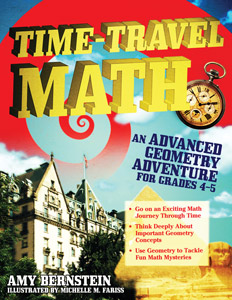Time-Travel Math is a supplemental math book with three time-travel adventures that lead students into the exploration of geometry and its applications. Since the book was written for above average fourth and fifth grade students, it might also be used with students beyond those grade levels.
The main characters are two inquisitive children, Harriet and Thomas, who discover a magical time-travel portal at the Dakota apartment building in New York City. Using the portal, they travel back in time to help three famous people who are each in the midst of trying to figure out a mathematical concept for their work. In the three units of the book, they visit with a teenage Leonardo da Vinci who is trying to learn about ratios and proportions for drawing human figures, with a young M.C. Escher who is working out the role of symmetry and angles to create tessellations, and with the ancient Egyptian architect Imhotep who is trying to determine how to build a pyramid for his pharaoh.
Each unit begins and ends with a time-travel story, but sandwiched in the middle of each unit are six to eight lessons that also advance the story while providing activities for students to explore and apply math.
For example in the third lesson of the first unit, students work with a chart showing various measurements of eight different people—e.g., height, arm span, foot length, heel to knee distance. They determine the averages for each measurement as well as the ratios between certain measurements to arrive at ratios that can be used when drawing human figures. While students will use math to solve some problems and complete some exercises, the emphasis is on conceptual thinking and applications.
Abstract thinking questions are included within each unit. These should ideally be discussed with a parent or teacher. The book was written for above average students, so some of these questions might be extremely challenging for some students. The answer key includes explanations that will likely be very helpful for both teacher and student.
A few hands-on activities are included. One relatively simple activity has students use paper and tape to create appropriately-sized furniture for a figure, applying what they have learned about proportions and ratios. The most involved project is creation of a tessellation quilt. (A single student might simply create a single panel rather than an entire quilt.)
Time-Travel Math is an entertaining vehicle that should draw students into a deeper engagement with geometry concepts. It should challenge their thinking, maybe even stumping them from time to time. Nevertheless, the practical applications should help them better understand the critical role that math concepts play in real-life.









